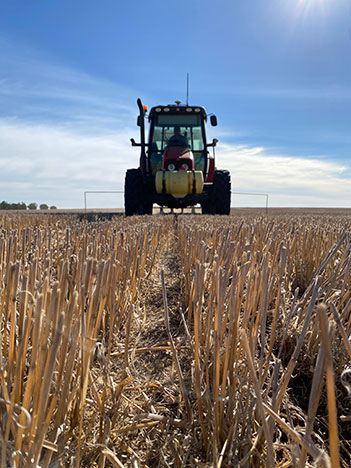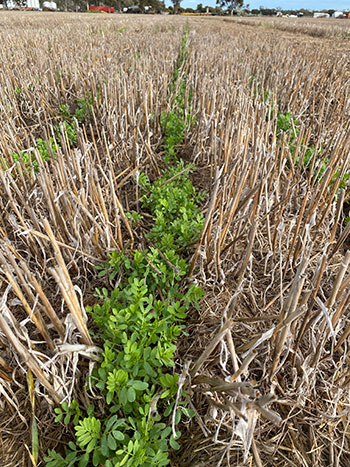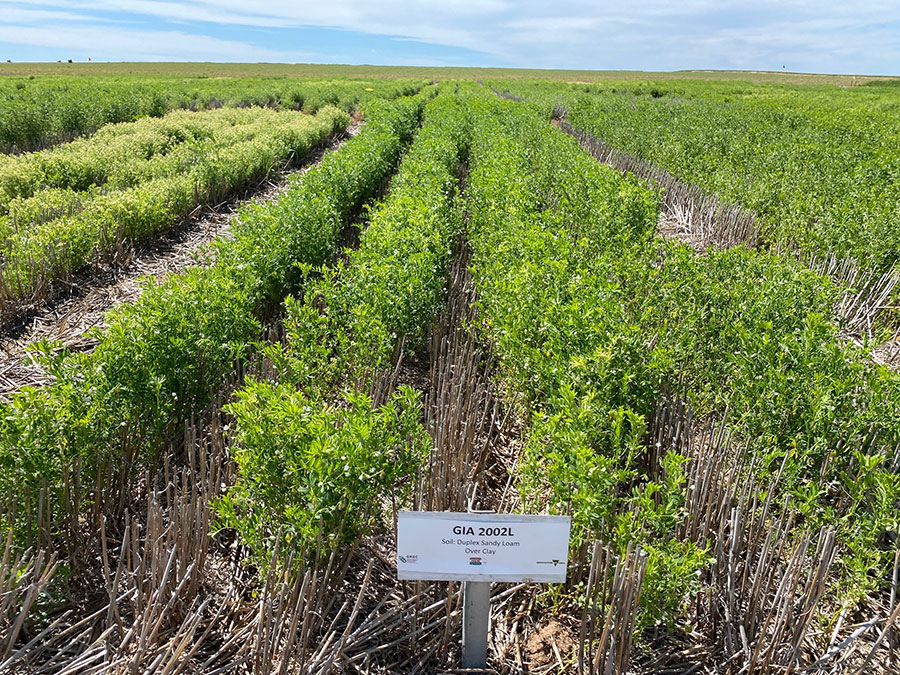West Wimmera growers are adopting pulses to help them improve soil health, in-crop weed control and farming system profitability.
Snapshot
Owners: Lowe Family Trust
Location: Propodollah, Victoria
Area: 2200 hectares of owned and leased country
Average annual rainfall: 340 millimetres
Soil types: black cracking clay to sandy rises
Soil pH range: 5.5 to 7.5
Crops grown: lentils, oaten hay, wheat, barley, vetch hay, clover, canola
Enterprises: cereals, oilseeds and legumes
After assessing the performance of a trial of lentils direct-drilled into barley on his property last year, a Wimmera grower has sown the pulse as part of his cropping rotation in 2022.
 Grower Jade Lowe’s property in the West Wimmera region. Photo: Jason Brand
Grower Jade Lowe’s property in the West Wimmera region. Photo: Jason Brand
A pulse agronomy trial site last year at Propodollah, in Victoria’s West Wimmera region, was established to assess the value of legumes in a vetch and cereal growing system. The trials were established in partnership with Agriculture Victoria as part of the GRDC Pulse Agronomy project (DJP2105-006RTX), which aims to close the economic yield gap and maximise farming system benefits from grain legume production in Victoria.
The trial was held on the property of Jade Lowe, who grows cereal, oilseed and vetch crops in rotation. Jade also grows beans, clover and wheat on a leased block at Goroke. The farm is heavy Mallee clay soils with sandy rises; soil pH ranges from 5.5 to 7.5 across the farm.
Jade farms in a mostly no-till system, but a Speedtiller is used for mixing clay and strategically to address problem areas, such as dealing with compacted wheel tracks. Like many growers in the district, he undertakes soil amelioration. The pulse trial site was selected to explore the adaptability of pulses across different soil types and in response to amelioration.
Soil amelioration has become more commonplace through the district due to emerging research and development and monitoring projects, including GRDC’s Sandy Soils project (CSP1606-008RMX). These projects focus on identifying and measuring microbial activity and organic matter in the soil, water filtration and storage, and improving soil and water erosion. Soil samples are helping to establish a baseline level of soil carbon across the Wimmera.
 Lentils direct-drilled into barley stubble at Propodollah, Victoria. Photo: Jason Brand
Lentils direct-drilled into barley stubble at Propodollah, Victoria. Photo: Jason Brand
“We do a bit of ripping and claying every year. We use a big scraper bucket to dig up the clay, spread it across the paddock and mix it into the soil,” Jade says.
The clay brought to the surface is mixed into the top 450 millimetres of soil. Mixing is key to opening up soils and providing the roots of plants with a strong base to descend into and hopefully tap into stored moisture.
He also spreads a mixture of lime and gypsum across the property and applies a light rate of gypsum when he sows canola.
To enable him to make more-effective decisions about when and where to apply fertiliser across the farm, and applying the lessons from trials on his farm last year, Jade is investing in more soil tests – increasing from two to three a year to 10 this year.
“We’re doing a lot more soil tests this year to better manage how much fertiliser we use and where and how it’s applied to be most effective,” he says.
Jade and a neighbour have installed soil moisture probes in a joint project with the Woorak Community and Land Management Group, in the Hindmarsh Landcare Network and Wimmera Catchment Management Authority. These probes will help them to monitor soil moisture profiles and the project is part of a wider data monitoring project in the low-medium rainfall environment in the northern Wimmera region.
It is part of a range of changes implemented by growers in the district to try to offset the effects of unseasonable storm events and dry periods in spring. Jade is one of a number of growers who have maintained standing stubbles with their direct-drill sowing strategies. The deep soil moisture probe is intended to provide data about moisture that helps decision-making about the following crop.
Table 1: Propodollah, West Wimmera – 2021.
| Average crop yields | Comparing soils | ||||||
|---|---|---|---|---|---|---|---|
| Crop | Mean (t/ha) | High | Low | Profit ($) | Price ($/t) | Flat (t/ha) | Sand (t/ha) |
| Lentil | 1.8 | 3.2 | 1.3 | 1620 | 900 | 1.77 | 1.79 |
| Faba bean | 3.3 | 4.0 | 2.5 | 1485 | 450 | 3.11 | 3.54 |
| Field pea | 2.9 | 3.6 | 1.9 | 1392 | 480 | 2.48 | 3.14 |
| Chickpea | 1.9 | 2.2 | 1.5 | 1520 | 800 | 2.05 | 1.83 |
| Vetch | 4.2 | 2.0 | 6.4 | 924 | 220 | 4.00 | 4.32 |
Sand
- Delved sandy rise – pH(CaCl2) 0–10cm = 7.2, increasing with depth to 8.3.
- Hard setting layer (~30cm)
Flat
- Duplex sandy loam (pH(CaCl2) = 6) over clay at 10–30cm (pH(CaCl2) = 8)
Lentil intentions
As a result of last year’s trial with lentils, and for the first time in decades, Jade has planted 260 hectares of the pulse this year.
“I agreed to the trial because I wanted to see how pulses grew on our farm and in our soils,” he says. “I think they’ll be a good break crop from cereals, helping control diseases, fixing nitrogen, helping improve weed management and soil health.”
He sowed lentils with a disc seeder at 45 kilograms/ha with 50kg/ha of monoammonium phosphate, and at a depth between 15 to 30mm.
“The yields last year from the high-yielding varieties in the lentil trials plot were 2.1 tonnes/hectare. Numbers like that make it worth growing. It’s about 30 years since we grew lentils.”

Lentils showing the effects of frost at the Propodollah trial site. Photo: Jason Brand
In comparison, the reported district average was 1.8t/ha. With lentil prices around $1000/t, that also represents a respectable return on investment.
Anzac Day is generally the district’s starting date for sowing crops.
Jade sowed lentils along with vetch, barley and oaten hay.
Jade was very happy with the visual results from the trial of lentils in barley stubbles on his property. Having seen results from the trials, he was motivated to grow lentils this season.
More information: Jason Brand, jason.brand@agriculture.vic.gov.au; Jade Lowe,
Pulses prove profitable at Propodollah
Pulse agronomy trials were established at the Propodollah, Victoria site in 2021 to look at the varietal adaptation of lentils, chickpeas, field peas, faba beans and vetch to varying soil types within a paddock. The paddock had previously been ameliorated.
The trial varieties growing on the site were spread across a sandy duplex ameliorated rise and a heavier duplex soil that was at a topographically lower area of the paddock.
The site was also used to measure growth and yield responses against:
- weed management strategies with the new lentil herbicide tolerance traits;
- optimising nitrogen fixation with inoculation; and
- agronomic strategies including sowing direction, row spacings and stubble to control pod drop in lentils.
Good rainfall in January gave way to a dry and patchy pattern of rain in late summer and autumn. Time of sowing for the trial was 6 May 2021.
The paddock used for the trial at Propodollah had previously grown barley, and the trials were sown into standing stubble. Seed was direct-drilled inter-row with narrow points and press wheels using a four-row cone airseeder set on 14-inch (355.6-millimetre) row spacing.
All trials were inoculated with appropriate granular inoculants. Fertiliser was applied at 80 kilograms per hectare of monoammonium phosphate plus 2.5 per cent zinc. Knockdown herbicides were used to set up the site for all trials, except those with a weed control focus.
The first significant rains in late May resulted in late and patchy germination of seed, with cool soil conditions affecting the early vigour of crops.
Agriculture Victoria research agronomist Dr Jason Brand, who leads the project, says the trials highlighted the fact that pulses can be productive and profitable even under challenging growing conditions.
“Most trials were sown dry in the first week of May, with crops germinating in early June, and patchy establishment over a six-week period,” Dr Brand says.
Good rainfall in July resulted in localised waterlogging in the duplex soil.
Given establishment of the lentils in cool conditions and sensitivity to waterlogging, I’d estimate yield was potentially halved in some of the lentil plots.
The site was affected by frost during the season, with crops growing in lower areas of the paddock being significantly affected by frost events. Despite frosty conditions and challenging soil types, grain yields in lentils across the site ranged between 1.3 and 3.2 tonnes per hectare. Frost events highlighted significant differences in variety responses to frost, with chlorosis (yellowing) of crops occurring in susceptible lines.
“These trials have provided data to support ranking of frost susceptibility in lentils,” Dr Brand says. “Excitingly, there were several new ‘imi’ varieties that were consistently high-yielding across soil types. It was a good example of the impact of variation in soil types on variety response and yield.”
Despite seasonal challenges, the trials highlighted which agronomic practices can be implemented to minimise risks and improve chances of success in growing pulses in variable soil types. The trials also demonstrated all pulses, with the standout of lentils, were highly profitable on the site.

























































